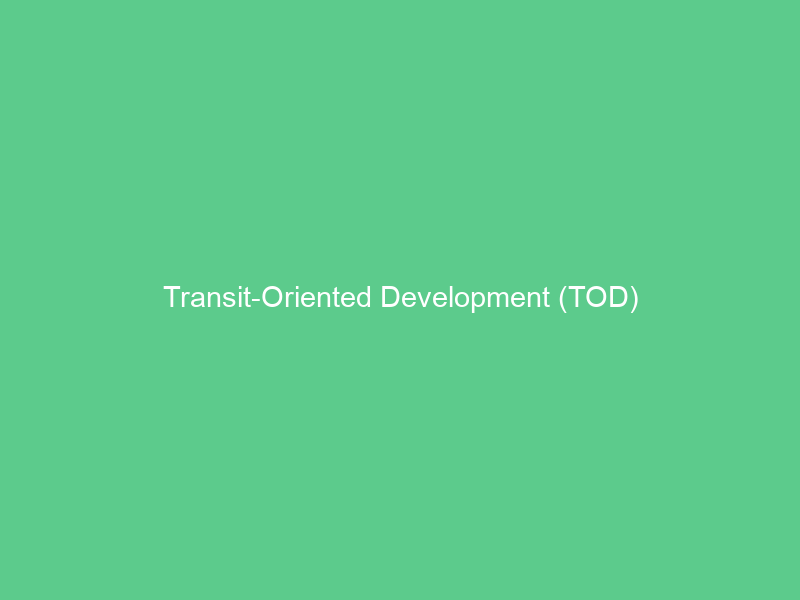TOD can effectively reduce per capita motor vehicle travel by providing jobs, services and housing near high-capacity transit stations – potentially increasing productivity while decreasing greenhouse gas emissions.
TOD often refers to light rail and rapid bus transit systems; however, TOD can also improve access for walking and bicycling to various modes of transport. Communities can implement TOD by adopting land use policies and building codes that encourage walking and bicycling near transit stops.
What is TOD?
Many new or existing neighborhoods already incorporate TOD elements, but there are various ways that this concept could be enhanced further. Reclaiming underutilized sites without displacement is one such method which could help revitalize communities while increasing walkability within them while making better use of land resources and creating more activity zones and options for sustainable transportation modes.
TODs typically center around transit stations with dense residential and commercial development located near buses, trams or light rail lines. Furthermore, TODs can include Park-and-Ride facilities for commuter parking purposes.
TOD is considered an integral component of sustainability as it encourages active lifestyles while simultaneously decreasing air pollution, traffic congestion and energy usage. Furthermore, TOD increases economic opportunities for local businesses while creating value in properties. TOD has become increasingly popular worldwide and has shown to deliver significant advantages for communities, their residents and the environment alike.
Why is TOD important?
TODs can play an integral role in cities’ efforts to advance economic growth and reduce private vehicle dependence, while simultaneously encouraging healthy lifestyles by encouraging citizens to walk or ride bikes more often, mitigating climate impacts and decreasing emissions from automobiles. TOD is particularly advantageous for younger generations like Millennials and Gen Zers who tend to opt for public transport over car culture.
Effective TOD requires taking an integrated approach to land use planning, transportation planning and urban design. TOD can be implemented at various scales: site, station area corridor or city or regional.
TOD can be an important way for transit agencies to increase ridership and revenue, but it does present its own set of challenges: for instance, TOD could contribute to gentrification and reduce affordability in low-income neighborhoods; furthermore, city leaders often fear it could lead to increased traffic congestion as another concern of TOD development.
What are the benefits of TOD?
TOD offers numerous advantages for individuals, cities and the environment alike. These benefits can range from reduced dependence on cars, increased affordability and environmental advantages such as less congestion and decreased carbon emissions.
TOD neighborhoods are designed to be walkable, featuring mixed use properties near public transit stations. This facilitates walking, bicycling and public transit use – which reduces car ownership and traffic congestion as well as air pollution, greenhouse gas emissions, greenhouse gas savings for businesses as well as reduced transportation expenses for residents.
TOD can boost economic activity as residents live closer to shops and restaurants. But its implementation must be carefully considered to ensure its benefits for all stakeholders involved, particularly as there could be negative ramifications of TOD such as displacement of low-income or marginalized communities, increased property values, social homogenization and infrastructure strain. In order to minimize these risks, TOD planners must listen to all stakeholders before planning process begins and implement strategies designed to prevent gentrification or displacement.
What are the disadvantages of TOD?
TOD requires a significant shift in planning philosophy and approach. It engages a much wider group of stakeholders than traditional development: local governments, developers, lenders, community groups and transit agencies all bring different goals to the table that may conflict or even work against one another.
TODs provide one clear benefit in that they foster walkable cities. This means less traffic and an environment more suitable for pedestrians – particularly elderly individuals and people living with disabilities. Furthermore, TOD helps decrease air pollution levels as well as greenhouse gas emissions.
TOD can have serious negative repercussions, including gentrification and lack of accessibility for low-income and minority residents. TOD tends to be built in core areas where land prices are highest – making it harder for lower income and minority groups to afford homes near transit stations. Planners must keep these considerations in mind when developing TOD projects as well as seek new research on its effects on travel behavior and how it could be tailored toward creating equitable results.

